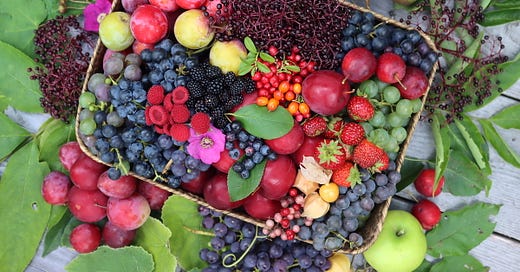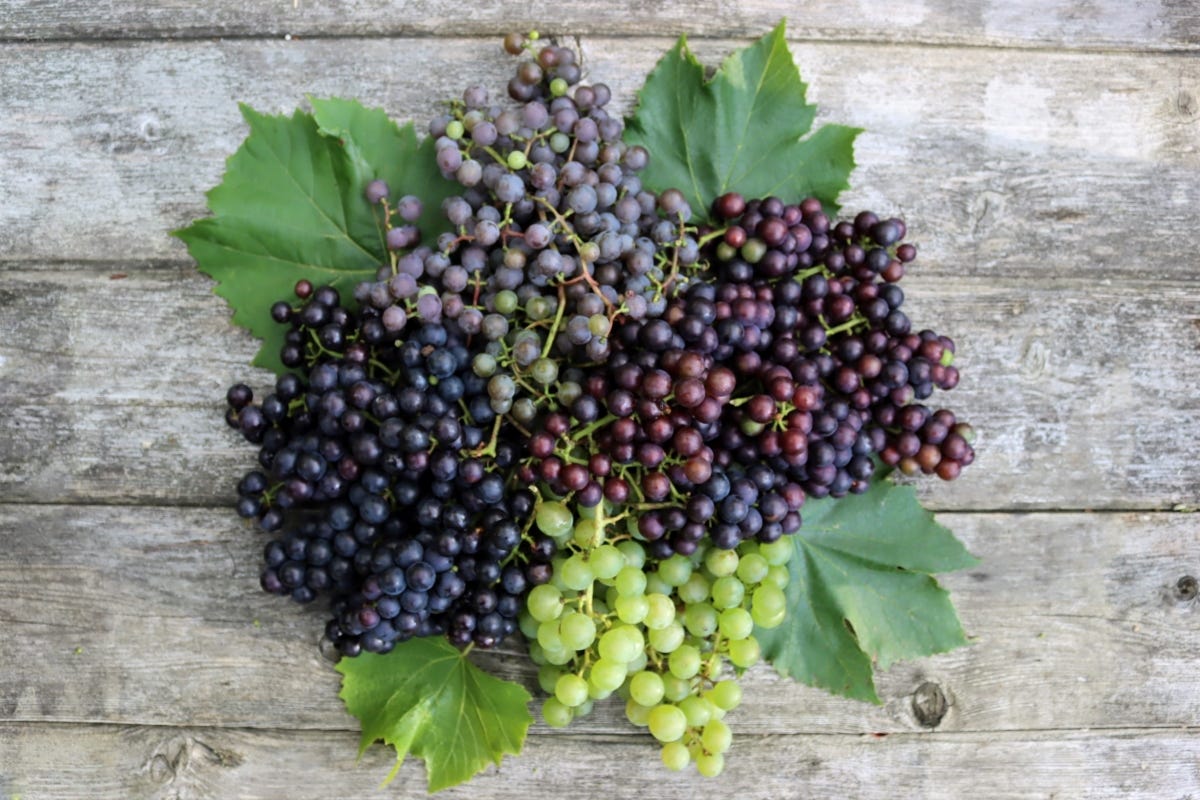Early September 2022| Practical Self Reliance
Late Summer Harvests, Grape Wine, Sea Berries & Chicks
Late August into Early September is peak harvest season around here, and we still have many of the small fruits from the summer months…but the larger trees are also beginning to bare as well. It’s when we have more variety on hand than any other time of year.

It’s not just variety; it’s quantity too.
Summer fruits come in cute pints and baskets…September fruits come in buckets and wheelbarrows.
We planted grapes on just about every fence line on the property, and then promptly forgot about them. They grow wild, and we cut off pieces to propagate them anytime we put up a new fence. It creates privacy and keeps the deer from jumping into the garden (as deer usually won’t jump over a fence if they can’t see what’s on the other side.)
It also means literally buckets of zero-effort fruit for our table, plus even more to keep the birds fed, which in turn keeps the mosquitos and deer flies down…
Really, we plant grapes as a mosquito repellent…the wine is just a nice bonus (honest).
We grow around a dozen varieties of grapes, even here in zone 4. Most are considered “wine grapes,” but that just means they’re intensely sweet…sweet enough to make a nice wine without added sugar. Most fruits aren’t that sweet, and even the sweetest peaches need added sugar to make peach wine.
Wine grapes also make an excellent grape jelly or old-fashioned grape jam.
Later this month, I’m going to be taking paid subscribers through the process of making grape wine at home.
I’m also hoping to do a detailed tutorial on all-grain beer brewing here on substack this month (to accompany my beginner’s guide to brewing beer on the blog, which covers modern extract and kit beer brewing). Brewing from “all grain” is how they did it 50, 100, and even 10,000 years ago. Every autumn, a part of the fresh grain harvest would be turned into liquid bread for the long winter ahead.
If you’re at all interested in brewing, nows a great time to check out paid subscriptions…and the button below gives you a 30-day free trial.
That’s more than enough time to check out the archives and decide if you like what you see there, as well as give you access to see this month’s paid subscriber-only winemaking and homebrewing articles.
If it’s something that you see value in, awesome. If not, no worries, just switch back to being a free subscriber before the end of the month, and you’re not out a cent.
(If you’re wondering why I have paid and free subscription options, I cover that in detail here. In a nutshell, writing DIY articles is my full-time job, and how I support my family. Your support is totally optional, and the main newsletter will always be free. The paid option just helps me create content without ads and other distractions.)
Grapes, in theory, have everything you need to make a high-quality wine…and it’s about blending and tending the wine to make sure it works out right.
I talk about this to some extent in my articles on apple wine versus hard cider.
Apple wine can be made with anything, even store-bought jugs of pasteurized juice. You add sugar, winemaking tannin, acidity, and everything else that’s needed to make a nice balanced wine.
Hard cider, on the other hand, requires blending the exact types of juice you need to make a good beverage. Something with enough sugar that it doesn’t end up too dry after the yeasts are satisfied, with enough acidity to be interesting and enough natural tannin to create body. The juice has to do all that on its own, and the same goes for grape wine.
(Of course, there are techniques for making wine with store-bought juice, whether it’s wine grape juice in a winemaking kit or even just jugs of concord grape juice or white grape juice. There’s also grape mead, known as pyment, which is truly excellent. I’ll cover all those as well, so don’t worry if you don’t have homegrown wine grapes.)
While grape wine can be a bit tricky, most country fruit wines are really incredibly simple.
At this point, I have more than 20 different fruit, flower, and even vegetable wine (and mead) recipes up on the blog, and with this plum harvest, I hope to add plum wine before the month is out as well.
Look for that one on the blog soon.
My constant companion, anytime I’m in the yard, is this short little cutie on stubby little corgi legs. He follows me around the yard and eagerly starts eating whatever I’m picking.
It’s no wonder dogs evolved alongside humans, following bands and getting led to good harvest spots (it works in both directions, each leading in turn).
Dogs are omnivores, and this one did a number on our black raspberries and blueberries this year. They’re color blind, or so I’ve read, so he’d watch until I reached for a cluster of blueberries, knowing that’s where the ripe ones were.
When I went up to our sea buckthorn, he actually leaped 5 feet in the air to harvest them…and got a nasty surprise with their big thorns (he was undeterred and did it again and again, no worries).
We didn’t have much of a seaberry harvest this year, but my friend Maria at Cate Hill Orchard saved a few pints of hers so I could experiment with recipes this year. These are a mix of her farms and our own.
They taste like a cross between an orange and a pineapple, but without sweetness.
They’re incredibly tart and acidic, but wonderfully tropical. As close as you can get to an orange up here in the north, and they’re truly excellent as a juice mixed with a bit of honey.
I’ll pop them in my mouth straight because I don’t mind an intense tropical sour kick…but most people juice them and sweeten them. They’re considered a “superfood” and Ben Falk talks about them quite a bit. He makes his into an oxymel for a winter immune boost.
They’re incredibly high in antioxidants and vitamin C, and with a pH is around 2.5, they’re more acidic than oranges, but not quite as acidic as lemons…and they can up nicely as a sea buckthorn-aid concentrate.

I have 6 more pints of sea buckthorn berries in the freezer now, and I’m hoping to do a lot of recipe development with them this winter. There’s not too much out there on the internet in terms of recipes, and I hope to change that.
It’s mostly because they’re kind of a niche fruit that’s mostly grown in the far North…but they’re becoming more popular in permaculture circles since they’re really easy to grow, incredibly hardy, and nitrogen-fixing (so they can grow on the poorest of soils).
Freezing the berries also helps to cold stratify the seeds inside, as they need a period of frozen dormancy before they’ll germinate. More little sea buckthorn babies will be in the works next year…
Our baby chicks arrived this week too, and they were met with much excitement by the littles. I wrote a while back that we’re moving, but not quite yet…so we’ve stopped putting our life on hold as we wait for our eventual relocation.
It’s really been life-changing, living in this space even though we no longer think of it as our forever home.
In the past 3 weeks, we’ve cleared about a quarter of an acre of scrubby woodland for our little friends, and we’ve retrofitted our pig barn to accommodate them. I’ll share a bit more about that process in my next newsletter.
At this point, we’re mostly snuggling these cute little “fluff-a-muffins” as my daughter calls them, and eagerly awaiting a rainbow of eggs next spring.

What are you harvesting, preserving, building, or exploring on your homestead this week? I’d love to hear about it!
Leave me a note in the comments…
(Comments only, please. Emails tend to get lost in my inbox, and as much as I’d love to get back to each and everyone, my screen time is very limited…and things fall through the cracks, and emails get buried in my inbox. If you comment here, they’re all in one place, and it’s much easier to get back to every single one.)
Until Next Time,
Ashley at Practical Self Reliance









My raspberry harvest has been decimated by Japanese beetles. Those f$@#ing things ate all the wild blackcap raspberries in our woods, and are doing their best to eat our cultivated raspberries as well. Any advice for deterring them? We sprayed neem oil early in the season but it seems to have done nothing.
So looking forward to the seaberry recipes!! I remember looking for recipes last year but couldn't find a whole lot out there as well